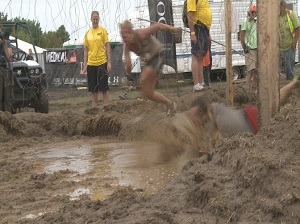Over the past 6 months I’ve been running a few times a week as a way to get some decent exercise while I try to get to a more healthy weight.
Not an activity that I liked until I was about 30, I do most of my running on treadmills while I watch sports and listen to podcasts. There are a few guys on my hockey team who have taken up endurance mud running as a way to work off the chicken sandwiches and beer we consume every Monday night. A couple of them ran the Tough Mudder in South Carolina a couple of years ago and are trying to talk me into joining them in the spring. Not sure I’m into it.
From the organizer’s website, “Tough Mudder events are hardcore 10-12 mile obstacle courses designed by British Special Forces to test your all around strength, stamina, mental grit, and camaraderie. Triathlons, marathons, and other lame-ass mud runs are more stressful than fun. Not Tough Mudder. As hardcore as our courses are, we meet you at the finish line with a beer, a laugh, and a rockin’ live band.”
The site lists a set of obstacles with names like Arctic Enema, Dirty Ballerina and Kiss of Mud.
The races have a history of testing more than physical and mental toughness – they have been linked to multiple pathogen outbreaks.
A 2012 Tough Mudder in Scotland was linked to at least three cases of E. coli O157. Last year a Michigan event recent was linked to norovirus.
According to Mlive, the organizers of this weekend’s Michigan event are addressing pathogen concerns.
Tough Mudder officials want to remind anyone planning to compete or attend this year’s event to practice good hygiene before and after attending.
“Illnesses of this nature are extremely rare. More than 1.5 million Mudders have run a Tough Mudder course; this issue is highly isolated,” said Ben Johnson, a spokesperson for Tough Mudder, via email. “However, safety is our No. 1 priority, and we encourage all participants, spectators, and volunteers to take the following preventative measures:
– It is important to not attend the event if you are feeling ill. We can provide a transfer to a future event.
– Practice good hygiene before and after the event:
Stay home for at least 48 hours after symptoms disappear.
Use chlorine-bleach based household cleaners to disinfect contaminated surfaces.
Free transfers to a future event is a good step – maybe that will result in sick folks skipping it until they’re done shedding pathogens.
